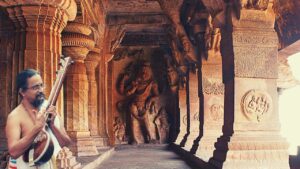Tanjore Painting

Source: Wikimedia Foundation
This month’s quiz is based on the Thanjavur (or Tanjore) Painting art form, a popular form of textile art involving hand painted designs using natural powders mixed with gum arabic, which originated in Thanjavur, Tamil Nadu.
1. What is the most distinguishing characteristic of Thanjavur Paintings?
a. Gold leaf
b. Canvas
c. Wooden frame
2. Thanjavur paintings usually depict _______________.
a. Historical events
b. Hindu religious deities and scenes
c. Nature
3. Where were Thanjavur paintings traditionally displayed?
a. Markets
b. Temples
c. Homes
4. Thanjavur paintings are usually done on ______.
a. Canvas
b. Cotton
c. Silk
5. In earlier times, the dyes that colored Thanjavur paintings were made of _____. Now, artificial colors are used.
a. Vegetables and minerals
b. Ink and nuts
c. Plants and minerals
6. The scenes depicted in Thanjavur paintings are usually ____ dimensional and static.
a. One
b. Two
c. Three
7. The closest “cousins” to Thanjavur paintings include ________.
a. Kalamkari art and Madhubani art
b. Kalamkari art and Tirupati paintings
c. Madhubani art and Tirupati paintings
8. Thanjavur paintings can be distinguished from Mysore paintings through their usage of ____________ .
a. Natural dyes
b. Glass beads
c. Gems
9. The artists who pioneered Thanjavur paintings were originally from _____.
a. Karnataka
b. Kerala
c. Andhra Pradesh
10. One thing that distinguishes Thanjavur paintings from Western art is that they are very rarely ________.
a. sold
b. signed
c. drawn
11.The greatest influence on Thanjavur painting, out of all the Indian styles of painting, came from the ________ school.
a. Kalamkari
b. Vijayanagar
c. Tirupati
12. Thanjavur paintings were often commissioned by a patron, which means that they were ______.
a. Paid for before they were made
b. Not unique
c. Made specifically to the patron’s order
Answers
1- a, 2-b, 3-b, 4-a, 5-a, 6-b, 7-b, 8-b, 9-c, 10-b, 11-b, 12-c
Compiled by Shruthi Swaminathan, Bay Area, CA







1. A 2.b 3. B 4.a